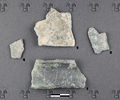BZ-26: Difference between revisions
From Thesaurus Inscriptionum Raeticarum
Jump to navigationJump to search
No edit summary |
No edit summary |
||
| (4 intermediate revisions by the same user not shown) | |||
| Line 1: | Line 1: | ||
{{inscription | {{inscription | ||
|reading=unknown!?]i : | |reading=unknown!?]i : terisna!terisṇ[ | ||
|reading_original=]{{c|N}}{{c|S}}{{c|I}}{{c|R}}{{c|E}}{{c| | |reading_original=]{{c|N}}{{c|S||d}}{{c|I}}{{c|R}}{{c|E}}{{c|T|T3}}{{c|punctuation|punctuation3}}{{c|I}}[? | ||
|direction=sinistroverse | |direction=sinistroverse | ||
|letter_height_min=1.7 cm | |letter_height_min=1.7 cm | ||
| Line 12: | Line 12: | ||
|language=Raetic | |language=Raetic | ||
|meaning=unknown | |meaning=unknown | ||
|object=BZ-26 | |object=BZ-26 fragment | ||
|position=rim | |position=rim | ||
|orientation=0 | |orientation=0 | ||
|craftsmanship=engraved | |craftsmanship=engraved | ||
|condition=damaged, fragmentary | |condition=damaged, fragmentary | ||
|sigla_tm=653544 | |||
|checklevel=1 | |checklevel=1 | ||
|problem= | |problem=Objektverlinkung | ||
}} | }} | ||
== Commentary == | == Commentary == | ||
| Line 25: | Line 26: | ||
Images in {{bib|Lunz & Morandi 2003}}: Fig. 3 (photo) and 4 (drawing). | Images in {{bib|Lunz & Morandi 2003}}: Fig. 3 (photo) and 4 (drawing). | ||
Length of the remains 5.5 cm. The lines are thin, but well visible; the reading is unambiguous. On the right, the remains of two vertical lines, the left of which can hardly be anything else than {{c||I}}. The separator consists in three short vertical scratches, and does not come up to the height of the letters. The hasta of {{c||E}} is inclined in writing direction; the second bar of {{c||N}} runs along the breaking edge | Length of the remains 5.5 cm. The lines are thin, but well visible; the reading is unambiguous. On the right, the remains of two vertical lines, the left of which can hardly be anything else than {{c||I}}. The separator consists in three short vertical scratches, and does not come up to the height of the letters. The hasta of {{c||E}} is inclined in writing direction; the second bar of {{c||N}} runs along the breaking edge. We can amend to {{w||terisna}}. Cp. [[index::BZ-4]], where this word is also preceded by a sequence ending in {{p||i}}. Cp. also [[index::BZ-27]]. | ||
{{bibliography}} | {{bibliography}} | ||
Latest revision as of 20:57, 8 November 2021
| Inscription | |
|---|---|
| Transliteration: | ?]i : terisṇ[ |
| Original script: | ] |
|
| |
| Object: | BZ-26 fragment (bronze) |
| Position: | rim |
| Orientation: | 0° |
| Script: | North Italic script (Sanzeno alphabet) |
| Direction of writing: | sinistroverse |
| Letter height: | 1.7 cm |
| Number of letters: | 7 |
| Number of characters: | 8 |
| Number of lines: | 1 |
| Craftsmanship: | engraved |
| Current condition: | damaged, fragmentary |
| Date of inscription: | 2nd half of the 5th century–1st century BC [from object] |
| Date derived from: | typology [from object] |
|
| |
| Language: | Raetic |
| Meaning: | unknown |
|
| |
| Alternative sigla: | TM 653544 |
Images
|
Object BZ-26 fragment with inscription BZ-26.
|
Object BZ-26 fragment with inscription BZ-26 (fragment 1).
|
Commentary
First published in Lunz & Morandi 2003: 345 ff.
Images in Lunz & Morandi 2003: Fig. 3 (photo) and 4 (drawing).
Length of the remains 5.5 cm. The lines are thin, but well visible; the reading is unambiguous. On the right, the remains of two vertical lines, the left of which can hardly be anything else than ![]() . The separator consists in three short vertical scratches, and does not come up to the height of the letters. The hasta of
. The separator consists in three short vertical scratches, and does not come up to the height of the letters. The hasta of ![]() is inclined in writing direction; the second bar of
is inclined in writing direction; the second bar of ![]() runs along the breaking edge. We can amend to terisna. Cp. BZ-4, where this word is also preceded by a sequence ending in i. Cp. also BZ-27.
runs along the breaking edge. We can amend to terisna. Cp. BZ-4, where this word is also preceded by a sequence ending in i. Cp. also BZ-27.
Bibliography
| Lunz & Morandi 2003 | Reimo Lunz, Alessandro Morandi, "Un frammento di elmo di bronzo con iscrizione retica da Settequerce – Siebeneich", Archeologia Classica LIV (2003), 341–349. |
|---|

